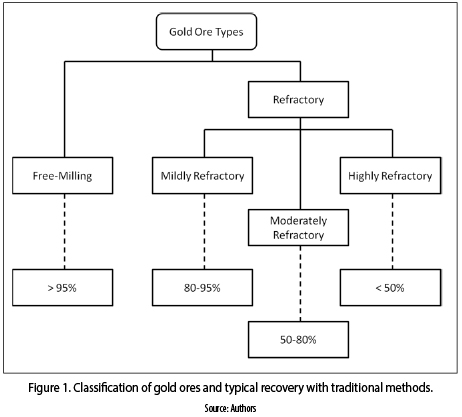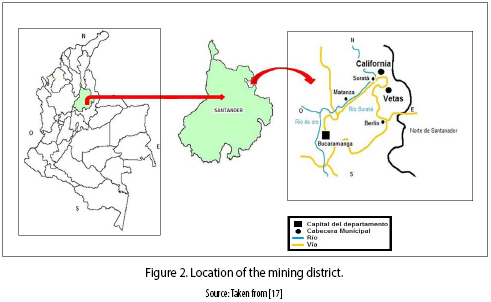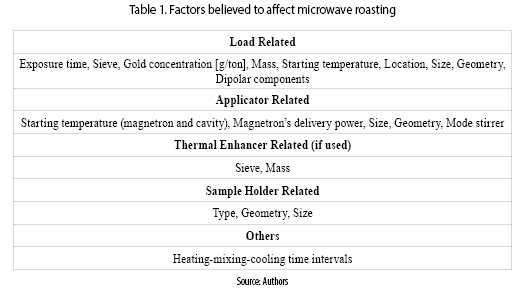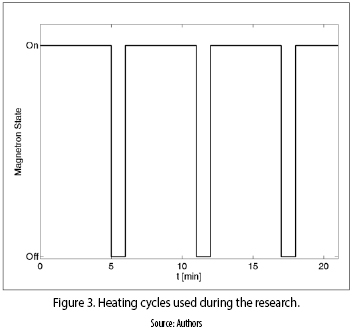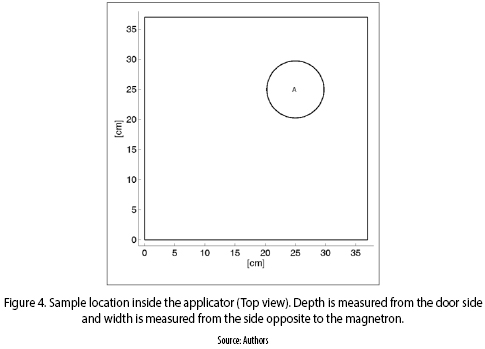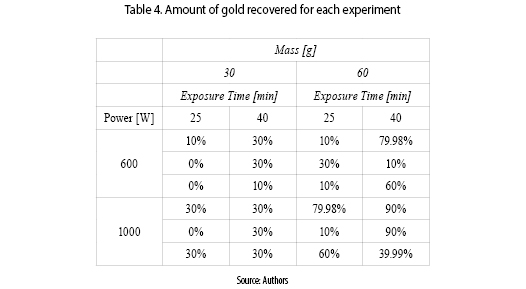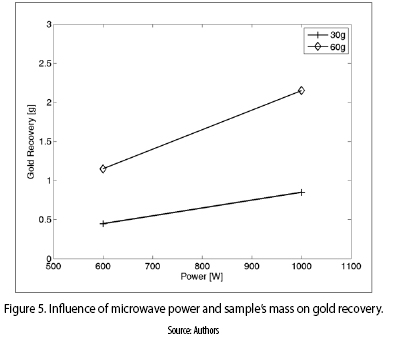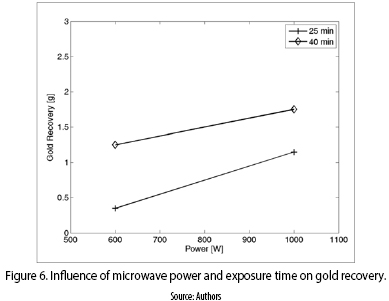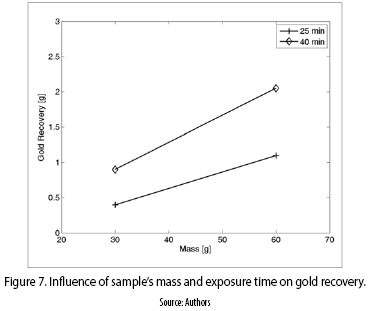Services on Demand
Journal
Article
Indicators
-
 Cited by SciELO
Cited by SciELO -
 Access statistics
Access statistics
Related links
-
 Cited by Google
Cited by Google -
 Similars in
SciELO
Similars in
SciELO -
 Similars in Google
Similars in Google
Share
Revista Ingenierías Universidad de Medellín
Print version ISSN 1692-3324
Rev. ing. univ. Medellín vol.14 no.26 Medellín Jan./June 2015
ARTICLES
Microwave assisted roasting for enhanced processing of Colombian gold mining samples
Tostación asistida con microondas para el procesamiento mejorado de muestras de minería de oro colombiana
Iván Amaya*; William Botero**; Rodrigo Correa***
* Mechatronics Engineer. Ph.D. (c) on Electronics Engineering. Universidad Industrial de Santander, Cra. 27 Cll. 9, (057–7) 6344000. ivan.amaya2@correo.uis.edu.co
** Electronics Engineer. Universidad Industrial de Santander, Cra. 27 Cll. 9, (057–7) 6344000. botts06@hotmail.com
*** Ph. D. Universidad Industrial de Santander, Cra. 27 Cll., 9 (057–7) 6344000. Professor, crcorrea@uis.edu.co
Recibido: 23/05/2013
Aceptado: 12/12/2014
Abstract
This research article, supported by Universidad Industrial de Santander (Vicerrectoría de Investigación y Extensión), shows the results achieved after using the electromagnetic cavity of a microwave oven and a temperature measurement system, to heat a mineral sample from the mining district of Vetas, in order to see if it was possible to induce a cheaper processing. A factorial design of experiment (DOE) was used to observe the effect of the microwave power, the exposure time and the sample's mass. It was found that an energy consumption reduction of 81.7%, and a time reduction of 75%, were possible to achieve while maintaining the recovery margin at 90% of the achieved with a traditional roasting, at lab level. Thus, it can be concluded that, at least for this ore, microwave roasting of the sample is viable at this scale. Moreover, if a better applicator were to be used, the benefits could be enhanced even more, so it is encouraged as a next step.
Key words: roasting, microwaves, gold, mineral ore, dielectric heating.
Resumen
Este artículo de investigación, apoyado por la Universidad Industrial de Santander (Vicerrectoría de Investigación y Extensión), muestra los resultados obtenidos luego de utilizar la cavidad electromagnética de un horno microondas, y un sistema de medición de temperatura, para irradiar una muestra mineral del distrito minero de Vetas, en aras de observar si era posible inducir un procesamiento más económico. Se utilizó un diseño de experimentos (DOE) factorial para observar el efecto de la potencia de la microonda, del tiempo de exposición y de la masa de la muestra. Se encontró que es posible obtener una reducción del 81.7 % y del 75 % para el consumo de energía y el tiempo de procesamiento, respectivamente, manteniendo el margen de recuperación en el 90 % del logrado con una tostación tradicional. Por tanto, se puede concluir que, por lo menos para este mineral, la tostación con microondas es viable en esta escala. Adicionalmente, si se llegare a utilizar un mejor aplicador, los beneficios podrían incrementarse aún más, por lo que se motiva como una siguiente etapa.
Palabras clave: tostación, microondas, oro, minerales, calentamiento dieléctrico.
Introduction
Throughout their history, mankind has always strived to exploit and use mineral resources. Whether it is for military, industrial or decorative means, they have always been there, even up to our days. Among them, gold is considered as a precious metal, and thus there is great interest on finding better, cheaper, and, recently, greener ways to process it. However, a considerable number of the current mineral deposits contain compounds and other characteristics that hinder the recovery margins of traditional means. Because of this, and as the years have gone by, different techniques that strive to enhance the process have appeared. They range from mechanical to chemical interactions, but in the end all of them try to disable the locking mechanisms that avoid the easy separation of gold particles from their mineral ore.
On a different topic, microwave based applications have evolved greatly. Since Faraday's discovery in 1831, and Hull's creation during the second decade of the 20th century, several inventions have taken place. These range from radar related, to heating ones [ 1,2] . In 1946, the US Federal Communications Commission (FCC) allocated the 915 and 2450 MHz bands for microwave ovens, and since then its market has been emerging and improvements are being made to different processes [ 3] . As opposed to traditional heating, where the energy is transferred through conduction, convection and radiation, the one generated by microwaves is based on the interaction of an alternating electromagnetic field and the material. This difference induces a volumetric heating in the material under test (MUT), which in turn tends to create an inverse heating profile (i.e. one where the hottest part is inside the MUT), whereas traditional heating creates what is known as a direct heating profile (i.e. the hottest part is the surface of the MUT). This apparently small difference can play a major role during a processing stage, and some important results are commented just below.
Some Previous Studies
The literature already shows that microwave heating can be used as an alternative to process some mineral ores (e.g. gold and iron) [ 4– 9] , since traditional processing face different problems. One of the most important is that there exists different kind of samples. Figure 1 shows a general classification, considering how easy it is to recover the mineral, as well as their expected recovery rates. It can be seen that processing of refractory gold ores can yield low rates, so they require implementation of extra stages, such as roasting, in order to eliminate the compounds that cause the refractoriness (e.g. sulfur–based compounds or carbon,), or grinding, in order to free smaller particles of gold that are trapped inside other elements or inside the gangue.
Amankwah et al. [ 4] performed an analysis of the influence of microwave heating in a free–milling ore. They found that by using dielectric heating, the crushing strength (an important variable for grinding) was reduced by 31.2 % and the reception of reagents was increased, thus reducing the leaching time from 22 hours to just 12. The percentage of recovery was over 95% (w/w), which complies with the recovery rate expected for a free–milling gold ore (see figure 1). The authors proposed some terms to rate a material response to the microwaves, which are inactive, active and hyperactive, being the latter the one that heats faster. One of the reasons they propose for the reduced time, is that due to the mixture of inactive and hyperactive materials, temperature rises quickly in some spots while remaining almost constant at others, thus creating thermal stress, which increases above the material's resistance and generates micro–cracks along the grain boundaries and through the grain itself.
There is also evidence of increased leaching rate from chalcopyrite, going from 10.2 % copper recovery without any treatment, to 32.21 % (and even up to 53.74 %) with microwave pre–treatment at low temperatures [ 10] . Kaya also explored the effect of microwave treatment in copper recovery. However, this time a sulfide ore was used and the results were restricted at observing the improvements in flotation. It was found that at high temperatures, flotation recovery is adversely affected, and that any economic gain achieved with an improved grindability will be outweighed by the loss in flotation [ 11] . It is important to remark that during this incipient economic analysis, the cost of grinding elements and the increased usable life of machines, was not accounted for, which could change the results. These studies provided interesting information, making gold recovery improvement worth deeper exploration. As stated by Agrawal et al. [ 12] , a metallic material begins coupling with microwaves if its temperature is around 400 ° C, which can be easily achieved if a thermal enhancer (such as silicon carbide) is used.
Some other interesting researches in the area have been the numerical modeling proposed by Whittles [ 13] , which can be used as a basis to simulate the benefits achieved through microwave processing. Also, the one by Nanthakumar et al., where successful results with a double refractory gold ore (one of the most difficult to process) are presented [ 14] , or the one by Amankwah et al., where more results with a free–milling ore are shown [ 15] , and the one by Kingman et al., where some more results regarding copper recovery improvement are shown [ 16] .
The National Scenario
Focusing on a more local context, it is known that Santander has a couple mining districts worth mentioning, which are California and Vetas, but since the sample used during this research comes from the latter, the former is not discussed. Figure 2 shows the location of the mining zone, which has an area of 139 km2 and a population of 4153. The ore extracted from Vetas has low–sulfidation, normally presenting pyrite composition below 5 %. The predominant metals are gold and silver, the latter being accompanied by zinc, lead or copper. This ore may also contain Mo, Sb, As(Te, Se, Hg), according to the study carried out by [ 17] .
This article shows the effect of irradiating a colombian gold sample (from the mining district of Vetas, Santander) with microwaves. The manuscript begins by showing the experimental set up used and some of the results, discussing them and finally concluding about the research. It was found, among other things, that time reductions in the order of 75 % were possible to achieve, when compared to roasting times from a traditional electric furnace, used during a laboratory scale smelting. Moreover, an energy consumption reduction of 81.7 %, while being able to recover 90 % of the gold, was achieved.
1 Experimental Setup
1.1 Exploratory Tests and Design of the Experiment (DOE)
A prior analysis was performed to try and find all the possible factors that can affect microwave roasting and, thus, gold recovery, which are summarized in Table 1. Factors believed to affect microwave roasting. With it, it was defined that during this research, a factorial experiment was going to be used. Three factors were chosen, with two levels per factor (see table 2), and three repetitions, so a total of 24 experiments were carried out in random order (so the experiment is unbiased). These levels were chosen because of different reasons. In the case of time, it was found that exposure under 25 minutes didn't roast the sample, whilst values over 40 led to sintering of the ore. Moreover, it was necessary to define some heating cycles, because oxygen is needed for roasting, and temperature needs to be homogenized. During this research, the exposure was split into stages of five minutes, allowing mixing and oxygenation during one minute, as shown in figure 3.
For the mineral's mass, 30 g was set as the lower level because it represents the amount of mineral that is required for traditional smelting at lab scale. The maximum was defined as its double (i.e. 60 g). Finally, the lower level of microwave power was defined at 60 % in order to use a value quite different from its maximum power (i.e. 100 %), but which will not increase the exposure time extensively. It is important to remark that the power was set using the microwave oven internal controller (i.e. the oven was configured via the front panel and keypad). The output variable was defined as the percentage of gold that can be recovered, after microwave roasting, with a traditional lab scale smelting.
1.2 Equipment and Sample Used
As it was mentioned in the introduction, a mineral ore from the mining district of Vetas (Santander) was used for the research. The sample comes from a mine known as ''Tajo Abierto'', and the first stage of the research focused on determining its grade. As a preliminary step, 576 737 g of the sample were ground in a ball mill, during 25 minutes, and then were separated by its sieve size. The four items with the highest mass were considered, and a traditional recovery was performed on them, obtaining the values from table 3.
As for the microwave applicator, a Whirlpool WM2014S domestic microwave oven was used. It has a design output power of 1000 W, at 2450 MHz, which can be varied from 20 % to 100 %, on 20 % intervals. The size of the applicator (i.e. the cavity itself) is of 37 x 37 x 22 cm, and the sample was located as shown in figure 4.
The reactor used during this research was a baked clay pot, with five holes through which the measurement system registers temperature. The latter, is an equipment that was designed at Universidad Industrial de Santander, and which was later modified by Aguirre et al. at the same university [ 18] . Finally, the equipment used to measure the power consumption of this alternate treatment is Dranetz's power quality analyzer, PowerVisa, which allows, among other things, to register energy consumption of a single–phase or triple–phase device.
2 Results and Discussion
2.1 Gold Recovery
After executing the experiments, a traditional lab scale smelting was performed on the samples, in order to verify if microwave roasting was a feasible treatment. The values from Table 4 were obtained, and it can be seen that the recovery margins ranged from 0 % and up to 90 %, using the traditionally obtained grade as a reference.
Moreover, an ANOVA analysis was carried out. Figure 5 shows the way in which the recovery is affected by the microwave power and by the mass of mineral ore. It can be seen that the configuration that provides the best results is to heat 60 g of mineral ore, with a microwave power of 1000 W, which is kind of expected, since a higher output power can allow for faster heating, and a higher mass means that more mineral can absorb the radiation, thus increasing its temperature more quickly.
On the other hand, figure 6 shows the influence of output power and exposure time, over gold recovery. Again, and according once more to logic, the highest exposure time, at the highest microwave power, yielded the highest recovery.
Finally, the influence of the exposure time and the mineral's mass was analyzed. Figure 7 shows that the heaviest sample, exposed for the most time, provided the best results, as was expected. Thus, it can be said that, under the conditions of the current research, it is best to heat 60 g of ore, for 40 minutes, with microwaves at a theoretical power output of 1000 W.
2.2 Analysis of Power Consumption
Using Dranetz's equipment, a measurement of the power consumed by the electric furnace and by the microwave oven was carried out. The former required 2.1 kW and 2.1 kVA of active and reactive power, respectively. The latter, working at 100 % of its output, only needed 1.2 kW and 1.25 kVA, which represents a reduction of 42.85 % and 40.47 %, respectively. Moreover, the processing time was reduced from 160 minutes, to 40 minutes. However, the peak temperature also decreased to around 400 ° C (as opposed to 750 ° C achieved with a traditional furnace). In spite of this, the amount of gold recovered was around 90 %, so a new sample was roasted in the furnace at 400 ° C, in order to verify if it allowed the same recovery margin. It was found that, after smelting, the amount of gold recovered was minimal (i.e. near zero), which could indicate that the microwaves generate a non–thermal effect on the mineral sample, or that the internal cracking due to thermal stress enhances smelting. Afterwards, the total energy consumption of both elements was analyzed. The electric furnace had a consumption of 5.2 kWh, while the microwave oven only required 0.95 kWh. This means that microwave roasting of this sample requires 81.7% less energy than a conventional lab process. Thus, it can be a feasible treatment from the economic and environmental points of view (at least at lab level), so a deeper research is recommended as a next stage.
7 CONCLUSIONS
During this article, the effect of microwave heating on the traditional processing of a mineral ore at lab level was shown. In this case, the research was focused on analyzing the feasibility of enhancing traditional roasting of mineral samples by using microwaves. It was found that energy consumption reductions of 81.7 %, while maintaining a gold recovery of 90 %, were possible, in a fourth part of the time used by the traditional process. It is important to remark that the microwave roasted samples only increased their temperature to 400 ° C, while traditional roasting requires about 750 ° C. In spite of this, a posterior smelting showed that the microwaves–based process is way more effective than the traditional one, since it yielded 90% of the conventionally recovered gold at a temperature 350 ° C lower. Moreover, a sample, traditionally roasted at 400 ° C did not allow for any significant gold recovery. This indicates that either there is a non–thermal effect produced by microwaves, or that the thermal stress generated with this type of dielectric heating, fractures the material in a way that enhances the smelting process. Thus, it is recommended to perform an X–ray diffraction, or a similar test, to observe the internal structure of both roasted samples, striving to compare them and see if there is any difference in their structure and/or chemical composition.
All of the results obtained during this research, were achieved with a domestic oven, whose only modifications were the removal of the spinning plate and the perforation of a couple holes used by the temperature measuring system. Therefore, if a proper microwave applicator is used (i.e. one with a controlled and focused field distribution), and if a deeper analysis of the sample and its interaction with the electromagnetic energy is carried out, this alternative may become a powerful strategy which can enhance the mining industry greatly. It is worth mentioning that our research group is already studying this scenario, using different kinds of samples to see if a generalization of the benefits is possible, and it is also looking for a way to expose the mineral ore to a uniform electric field, focusing the electromagnetic energy and striving to improve the time and energy reductions even further.
4. ACKNOWLEDGEMENTS
This work was supported by Vicerrectoría de Investigación y Extensión (Universidad Industrial de Santander), in the framework of project 5551.
REFERENCES
[ 1] J. M. Osepchuk, ''Microwave power applications'', IEEE Trans. Microw. Theory Tech., vol. 50, n.° 3, pp. 975– 985, Mar. 2002. [ Links ]
[ 2] I. Amaya and R. Correa, ''Electromagnetic heating as a way of cutting costs while saving energy: Time evolution'', Rev. Ing. Univ. Medellín, vol. 11, n.° 20, pp. 215– 226, 2012. [ Links ]
[ 3] H. Sobol and K. Tomiyasu, ''Milestones of microwaves'', IEEE Trans. Microw. Theory Tech., vol. 50, no. 3, pp. 594– 611, Mar. 2002. [ Links ]
[ 4] R. K. Amankwah and G. Ofori–Sarpong, ''Microwave Heating of Gold Ores for Enhanced Grindability and Cyanide Amenability'', Miner. Eng., vol. 24, n.° 6, pp. 541– 544, May 2011. [ Links ]
[ 5] A. C. Gaviria C., J. González, and H. F. Mora, ''Tostación, empleando microondas, en menas refractarias auríferas y su efecto en la extracción del oro'', Rev. Dyna, vol. 73, n.° 150, pp. 29– 37, 2006. [ Links ]
[ 6] I. Amaya, D. Bernal, S. Garnica, M. Reslen, and R. Correa, ''Improved Roasting of Some Colombian Gold Ores'', Rev. Dyna, vol. 80, n.° 178, pp. 70– 77, 2013. [ Links ]
[ 7] S. M. Javad Koleini, K. Barani, and B. Rezaei, ''The Effect of Microwave Treatment on Dry Grinding Kinetics of Iron Ore'', Miner. Process. Extr. Metall. Rev., vol. 33, n.° 3, pp. 159– 169, May 2012. [ Links ]
[ 8] S. M. J. Koleini and K. Barani, ''Microwave Heating Applications in Mineral Processing'', in The Development and Application of Microwave Heating, W. Cao, Ed. InTech, 2012, pp. 79– 104. [ Links ]
[ 9] K. Barani, S. M. J. Koleini, B. Rezai, and A. Khodadadi, ''The Effect of Sample Geometry and Placement of Sample on Microwave Processing of Iron Ore'', Int. J. Appl. Phys. Math., vol. 2, n.° 2, pp. 131– 134, 2012. [ Links ]
[ 10] Y. Turkmen and E. Kaya, ''Leaching of Chalcopyrite Concentrate in Sulphuric Acid with the Aid of Mechanical Activation and Microwave Energy'', Asian J. Chem., vol. 22, n.° 10, pp. 8107– 8116, 2010. [ Links ]
[ 11] E. Kaya, ''Effect of Microwave Radiation on the Floatation of Copper Sulfide Ores'', Asian J. Chem., vol. 22, n.° 10, pp. 7874– 7882, 2010. [ Links ]
[ 12] D. Agrawal, J. Cheng, H. Peng, L. Hurt, and K. Cherian, ''Microwave Energy Applied to Processing of High–Temperature Materials'', Am. Ceram. Soc. Bull., vol. 87, n.° 3, pp. 39– 44, 2008. [ Links ]
[ 13] D. Whittles, ''Application of numerical modelling for prediction of the influence of power density on microwave–assisted breakage'', Int. J. Miner. Process., vol. 68, n.° 1– 4, pp. 71– 91, Jan. 2003. [ Links ]
[ 14] B. Nanthakumar, C. Pickles, and S. Kelebek, ''Microwave Pretreatment of a Double Refractory Gold Ore'', Miner. Eng., vol. 20, n.° 11, pp. 1109– 1119, Sep. 2007. [ Links ]
[ 15] R. K. Amankwah, A. U. Khan, C. A. Pickles, and W. T. Yen, ''Improved Grindability and Gold Liberation by Microwave Pretreatment of a Free–Milling Gold Ore'', Miner. Process. Extr. Metall., vol. 114, n.° 1, pp. 30– 36, Mar. 2005. [ Links ]
[ 16] S. Kingman, K. Jackson, A. Cumbane, S. M. Bradshaw, N. A. Rowson, and R. Greenwood, ''Recent developments in microwave–assisted comminution'', Int. J. Miner. Process., vol. 74, n.° 1– 4, pp. 71– 83, Nov. 2004. [ Links ]
[ 17] E. W. Carreño, ''Incorporación de Tecnologías Limpias para Beneficiar Minerales Auríferos en la Pequeña Minería de Vetas y California (Santander) Buscando Reducir Vertimientos de Mercurio y Cianuro'', pp. 1– 6, 2005. [ Links ]
[ 18] R. D. Aguirre and W. Botero, ''Interacción de las Microondas con Trazas de Oro en Muestras Provenientes del Municipio de Vetas (Santander)'', Undergraduate Thesis, Universidad Industrial de Santander, 2012. [ Links ]













